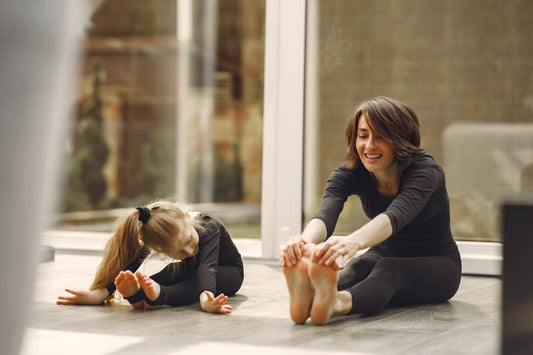
Set-Offers
Save when you buy a set
Shopping cart
Your shopping basket is empty
Yoga

Meditation
Bundles

| Wissen & Wirkung
We've talked about the many benefits of yoga for adults a few times on this blog - and probably most of our readers have had the same experience themselves.
But what about our little ones? Is yoga also suitable for children and from what age can children attend their first yoga class? What should parents and siblings pay attention to if their offspring want to do gymnastics at home on the yoga mat?
We clarify. :)

Yoga brings body, mind and soul into balance - this applies to adults as well as children. With yoga, children not only get to know their own bodies better, they also learn at the same time and almost automatically to remain calm and balanced even in hectic situations.
Yoga can, for example, protect even the youngest from pressure to perform and severe exam anxiety or alleviate stress symptoms.
At the same time, yoga promotes body awareness, the ability to concentrate and mindfulness , which are automatically trained when learning new movement sequences - skills that bring great advantages into late adulthood.
In general, children can start yoga as soon as they can walk - after all, yoga is for everyone!
However, you should be careful not to push or overwhelm the little ones, but to introduce them to the practice with fun and ease. Instead of a full power yoga class, for example, it makes sense to practice two to three asanas with the whole family and to make it all fun and family time.
The first children's yoga courses are offered from kindergarten age - but here, too, the focus should be on the game character, so that yoga does not just remain a duty, but becomes a hobby.
The classic utensils such as a gymnastics or fitness mat and a blanket to cover up (final relaxation) should not be missing during children's yoga either. Enough space is very important: Whether in the living room or in the playroom, if the child loses their balance and falls over, they should not be able to injure themselves on tables, chairs or cupboards that are standing around.
Not only furniture and toys, but also negative emotions should be put aside as far as possible before a yoga session so that the yoga session can be completed with a good feeling, fun and joy. A little fantasy trip to start with can help to get in the mood for the yoga session.
In general: fun, fun, fun! Laughter is not forbidden in yoga, on the contrary: the asanas can be combined with funny stories, if someone falls over, you can laugh heartily at yourself.
As with adults, nothing should be eaten about one to two hours before a yoga session. Some yoga exercises could "worry a little" the gastrointestinal tract in the little ones - but if you want, you can introduce a small yoga ritual with delicious snacks and tea afterwards.
Static yoga exercises, or asanas for short, require a relatively large amount of time and patience. Since children like to try out many yoga exercises, the individual asanas should not be held for too long at the beginning.
Additional recommendations for asanas with children:
In principle, children can perform most asanas, but we recommend starting with rather easy asanas and not putting too much strain on the cervical spine and joints. In our yoga sequence for children we therefore do without the headstand or the crow.
Shoulderstand (Sarvangasana)
The shoulder stand is suitable for mobility of the cervical spine and function of the thyroid gland. Calmness and concentration can be trained.
Cobra (Bhujangasana)
The cobra is popular with both children and adults. It strengthens the back muscles, relieves tension and generates an upright posture.
Bow (Dhanurasana)
An exercise that many children know from physical education. It strengthens the back muscles and massages the abdominal organs. Some children develop the arch into a "swing arch" by merrily rocking back and forth.
Conclusion: At a time when children bring or find less flexibility, muscle strength, mindfulness and relaxation, yoga can be used universally. Children benefit from the numerous possibilities that yoga offers for body and mind - and often also from the time spent together with the family.

You don't have to start your day with coffee or a green smoothie. You don't have to exercise for an hour before breakfast and you don't have to ta...
Continue reading
The fact that pranayama is as much a part of yoga practice for us as ketchup is of fries at the swimming pool is no longer a secret. Whether we ne...
Continue reading
There are no comments yet. Be the first to leave a comment!